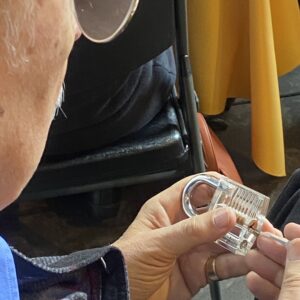The Beekeeper’s Apprentice
Laurie’s Adventures in BEEKEEPERing
Well, April was certainly busy. Two conferences, two Beekeeper’s 30th celebrations, all the flights and hotels and chatter those involve—and, I even wrote a bunch of new words. Not here on Mutterings, unfortunately, maybe I should fix that. As you may know, last year I decided to celebrate the anniversary of The Beekeeper’s Apprentice with…
Read MoreBeekeeper at the Libraries, #1!
Saturday sees the first in the Laurie Loves Libraries celebrations of the Beekeeper’s 30th birthday! This one’s a hybrid event, where I’ll be in my study talking with gathered patrons of the Williamsburg Library—and, with people online. I have to say, Williamsburg (headed up by the fabulous duo of Avery and Allison) really threw itself…
Read MoreJobs Can be Fun
Okay, I’ll admit it: these four Beekeeper’s Apprentice 30th anniversary celebrations I’m planning for next year? Yes, I suppose you have to call it all part of promoting the Russell & Holmes series, but honestly, I’m having just a ridiculous amount of fun with them. The speakers for the events are a kick, tying their…
Read MoreCelebrating BEEKEEPER, Four Times
If you don’t get my newsletter, you may not be aware that Team LRK is putting on four all-day celebrations of Thirty Years of The Beekeeper’s Apprentice during 2024. Each will have talks, demonstrations, fun & games, and exclusive giveaways. And maybe even a touch of education. February 17 in Santa Cruz, CA, will include a…
Read MoreThe BUZZ has a question
My newsletter, The Buzz, just went out–and there’s a survey in it asking if you’d like to come to one of the FOUR Russell & Holmes events being held next year. We’re in the process of negotiating with the hotels, so we need to have a rough idea of numbers. In case you didn’t get…
Read MoreBees Abroad
I had a perfectly charming Zoom meet on Friday with members of Bees Abroad, an organization in the UK that trains & supports African women & those with disabilities to become Beekeepers for Life. But these lovely people not only teach beekeeping skills, they also help people figure out how to sell honey and beeswax…
Read MoreThe many faces of Beekeeper
When you have a book that’s been around for 25 years, especially if it’s the first in a gratifyingly long series, the publishers tend to dress it in a lot of different ways. Funnily enough, The Beekeeper’s Apprentice didn’t strike the imagination of the in-house reader, who decided to pass on the paperback rights. They…
Read MoreGetting to Beekeeper
The other day I posted (over here) an image of the original cover proposal for The Beekeeper’s Apprentice, thanking the publishing gods that it went away in favor of the one St Martins Press ended up with. But a couple of you were curious about how that happened—so here’s that story. I first saw that…
Read MoreThe Early Beekeeper
This month, we’re celebrating the 25th anniversary of The Beekeeper’s Apprentice. I wrote about the early editorial letters in my newsletter (There’s also a giveaway of the audio–here) and will be celebrating it in various ways at Bouchercon, the end of the month. But this early cover proposal from St Martins Press has always cracked…
Read More103 years ago today…
…two people met on a patch of countryside: I was fifteen when I first met Sherlock Holmes, fifteen years old with my nose in a book as I walked the Sussex Downs, and nearly stepped on him. In my defence I must say it was an engrossing book, and it was very rare to come across…
Read More


